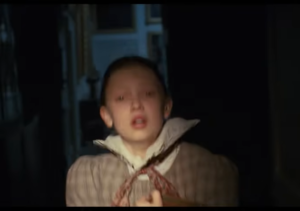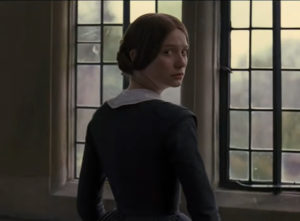Jane Eyre is a classic novel written by Charlotte Brontë and first published in 1847. The novel follows the life of the titular character, Jane Eyre, from her childhood as an orphan living with cruel relatives to her adulthood, where she becomes a governess and falls in love with her employer, Mr. Rochester. The novel delves into themes of love, morality, social class, and gender roles.
Short Plot Summary of The Novel
Jane Eyre, an orphan who faces hardship, prejudice, and betrayal, yet remains resilient in her quest for independence and love. Raised by her cruel aunt and subsequently schooled in a harsh charity institution, Jane becomes a governess at Thornfield Hall. There, she falls for the enigmatic Mr. Rochester, only to discover he harbors a dark secret. The revelation forces Jane to flee, but after a period of reflection and adversity, she returns to find a blinded Rochester, having lost his mansion to a fire. The two reunite, finding solace and love in each other’s company, defying the societal norms of their time.
Comprehensive Summary of “Jane Eyre”
Complete plot summary of “Jane Eyre” divided by the stages of her life:
Childhood at Gateshead
 Jane Eyre, an orphan, lives with her cruel Aunt Reed and her bullying cousins, John, Eliza, and Georgiana. She’s treated as an outsider and often punished unjustly. After a particularly violent altercation with her cousin John, Jane is locked in the “red-room,” the chamber in which her deceased uncle died. This traumatic experience leads to her falling ill, and it’s decided she should attend a school for girls.
Jane Eyre, an orphan, lives with her cruel Aunt Reed and her bullying cousins, John, Eliza, and Georgiana. She’s treated as an outsider and often punished unjustly. After a particularly violent altercation with her cousin John, Jane is locked in the “red-room,” the chamber in which her deceased uncle died. This traumatic experience leads to her falling ill, and it’s decided she should attend a school for girls.
Education at Lowood School
Jane is sent to Lowood, a charity institution. The school’s conditions are harsh, with cold rooms, poor meals, and strict discipline. However, Jane befriends a fellow student, Helen Burns, whose philosophical outlook on life greatly influences her. Helen eventually dies from tuberculosis, a devastating loss for Jane. Over time, the school’s conditions improve, and Jane receives a good education. After finishing her studies and teaching for two years at Lowood, she decides to seek employment elsewhere.
Governess at Thornfield Hall
Jane takes a position as a governess at Thornfield Hall, teaching a lively French girl named Adèle. She finds herself enjoying the company of the estate’s housekeeper, Mrs. Fairfax, and the mysterious master of the house, Mr. Edward Rochester. Over time, Jane and Rochester grow close, sharing deep conversations and mutual respect. However, strange events occur: mysterious laughter, a fire in Rochester’s room, and an attack on a house guest. Rochester attributes these events to Grace Poole, a seemingly harmless servant. Jane and Rochester confess their love for each other, but on their wedding day, it’s revealed that Rochester already has a wife, Bertha Mason, who is mentally ill and kept locked in the attic. Heartbroken and feeling betrayed, Jane flees Thornfield.
Flight to Moor House
Nearly dying from hunger and exposure, Jane is taken in by the Rivers siblings: Diana, Mary, and St. John. She soon discovers that they are her cousins. St. John, a clergyman, offers Jane a proposal of marriage, suggesting they go to India as missionaries. Though tempted by the offer of a familial connection and purpose, Jane realizes she doesn’t love St. John and cannot marry without love. She also inherits a fortune from her deceased uncle and chooses to share it with her newfound relatives.
Reunion at Ferndean
Drawn back to Rochester, Jane returns to Thornfield to find it burned to the ground by Bertha, who died in the fire. Rochester tried to save her and lost his eyesight and a hand in the process. Jane seeks him out at his new home, Ferndean, where they reunite. The novel concludes with Jane and Rochester marrying. Over time, Rochester regains partial sight, and they have a child together. Jane’s narrative ends with the assurance of their continued happiness and love.
Basic Information About The Novel
- Title of the work: Jane Eyre
- Author: Charlotte Brontë
- Date of Publication: 1847
- Original Language: English
- Genre: Gothic novel, Bildungsroman (coming-of-age novel)
- How long is it? Approximately 190,000 words (varies by edition)
- Form and Structure: Prose narrative, chronological, first-person point of view
- Setting: Early 19th century England; Gateshead, Lowood School, Thornfield Hall, Moor House, Ferndean
- Themes: Social class, gender roles, love vs. autonomy, the supernatural, religion, morality
- Publication Medium: Novel, presented as an autobiography edited by “Currer Bell” (Brontë’s pseudonym)
- Diction: Formal, 19th-century English, conveying internal struggles, societal constraints, and gothic atmosphere.
Main Characters Overview
Jane Eyre
The novel’s protagonist and narrator, Jane is an orphan who faces hardship from a young age. Despite her trials, she maintains a strong sense of morality and justice. As she grows, she desires love and acceptance, but not at the cost of her self-respect and independence. Her journey is one of self-discovery, love, and finding a true sense of home.
Edward Rochester
The brooding master of Thornfield Hall, Rochester is a complex character with a mysterious past. He is both Jane’s employer and the man she falls in love with. Though he is flawed and has made mistakes, he is deeply passionate and has a genuine affection for Jane. His past actions and secrets play a significant role in the novel’s plot.
St. John Rivers
A clergyman who is both Jane’s benefactor and her cousin. He is handsome, cold, and ambitious, with a strong sense of duty. While he proposes to Jane, it’s more for her suitability as a missionary’s wife than out of love. He represents a path of self-denial and sacrifice, contrasting with Rochester’s passionate nature.
Mrs. Reed
Jane’s cruel aunt who raises her at Gateshead. She resents Jane because her husband loved Jane’s mother (his sister) more than he loved Mrs. Reed. She represents the adversity Jane faces in her early life.
Bertha Mason
Rochester’s first wife, who is mentally ill and kept hidden in Thornfield. She is the “madwoman in the attic,” representing the dark secrets of Rochester’s past and the gothic element of the novel. Her existence is a significant barrier to Jane’s happiness.
Helen Burns
Jane’s friend at Lowood School. She endures her sufferings with a passive dignity that Jane cannot understand. Helen introduces Jane to the teachings of Christianity, emphasizing forgiveness and the rewards of Heaven.
Adele Varens
A French child under Rochester’s care, Adele is his ward, and Jane becomes her governess. She is lively and affectionate, providing a contrast to the often gloomy atmosphere of Thornfield.
Mrs. Fairfax
The housekeeper at Thornfield Hall. She is kind to Jane and serves as a maternal figure, offering advice and comfort. While she is loyal to Rochester, she is also wary of the house’s mysteries.
Additional Info And Analysis
Context
“Jane Eyre” was published in 1847, a time when the Victorian era was in full swing in England. This period was characterized by strict social hierarchies, moral rigidity, and a burgeoning industrial revolution. The novel reflects many of the social concerns of the time, particularly regarding gender roles, class, and the nature of love and marriage. Additionally, Brontë’s own experiences, including her time as a governess and her education at a religious school, influenced the novel’s content and themes.
Comparison with Other Works of The Author
Charlotte Brontë, along with her sisters Emily and Anne, contributed significantly to English literature. While “Jane Eyre” is a bildungsroman that traces the protagonist’s growth from childhood to adulthood, her other novel, “Shirley,” deals with industrial depression and the role of women in society. “Villette,” another of her works, also delves into the psyche of a young woman, Lucy Snowe, and her experiences in a foreign country. All these novels, while distinct in their narratives, share a deep exploration of women’s roles, emotions, and challenges in a restrictive society.
Reception and Criticism
Upon its release, “Jane Eyre” was an instant success with readers, though it did receive mixed reviews from critics. Some praised its originality and the boldness of its heroine, while others criticized it for being anti-Christian or too passionate. Over time, the novel has come to be regarded as one of the greatest works of English literature. Its exploration of social criticism, morality, and psychological depth has made it a subject of study and admiration in literary circles.
Comparative Analysis with Other Works of The Same Time
“Jane Eyre” was written during a time when the novel as a form was evolving and gaining respect. It shares thematic elements with other Victorian novels, such as Dickens’s works, which also comment on societal issues and personal morality. However, Brontë’s novel stands out for its deep introspection and the psychological complexity of its characters. When compared to other novels of the period, like “Wuthering Heights” by her sister Emily Brontë, “Jane Eyre” is less dark but equally intense, with both novels delving into themes of love, revenge, and societal constraints.
Some Mentionable Adaptations
Film:
- “Jane Eyre” (1943) starring Joan Fontaine and Orson Welles.
- “Jane Eyre” (2011) with Mia Wasikowska and Michael Fassbender.
Television: “Jane Eyre” (1983) BBC miniseries starring Zelah Clarke and Timothy Dalton.
Theatre: “Jane Eyre: The Musical” (2000) on Broadway, composed by Paul Gordon.
Books: “Wide Sargasso Sea” (1966) by Jean Rhys, a prequel to “Jane Eyre”.
Visual Art: “Jane Eyre” Graphic Novel (2009) adapted by Amy Corzine and illustrated by John M. Burns.
Intriguing Tidbits about “Jane Eyre”
- Semi-autobiographical Elements: Brontë infused parts of her own life into “Jane Eyre”. Like Jane, Charlotte Brontë lost her mother at a young age and had a difficult relationship with her aunt.
- Pseudonym: Charlotte Brontë originally published “Jane Eyre” under the male pseudonym Currer Bell to avoid the prejudices against female writers of her time.
- Immediate Success: “Jane Eyre” was an instant success upon its release, selling out within three months of its publication.
- Bertha’s Representation: The character of Bertha Mason, Rochester’s first wife, has been analyzed and reinterpreted over the years, especially in postcolonial literature. Jean Rhys’s “Wide Sargasso Sea” is a notable exploration of Bertha’s backstory, painting her in a more sympathetic light.
- Innovative Structure: “Jane Eyre” is considered one of the earliest examples of the bildungsroman, a novel that focuses on the psychological and moral growth of its main character from youth to adulthood.
- Influence on Literature: The novel has been credited with influencing the genre of Gothic romance as well as the modern romance novel. Its themes and character archetypes appear in many subsequent works
Personal Review of “Jane Eyre”
“Jane Eyre” is a captivating blend of romance, mystery, and social critique. Brontë’s portrayal of Jane as a strong, independent, and morally upright woman was groundbreaking for its time. The novel delves deep into issues of class, gender, and societal expectations, making it as relevant today as it was in the 19th century. The Gothic elements add a layer of suspense, while the romantic plotline between Jane and Rochester keeps readers engaged. However, some might find certain elements, like the portrayal of Bertha Mason, problematic from a modern perspective. Overall, “Jane Eyre” is a beautifully written, thought-provoking classic that offers rich insights into human nature and society.
📖 Loved “Jane Eyre” or have a different take? Share your thoughts below in the comments! I’d love to hear from you. 🖋️👇



Comments